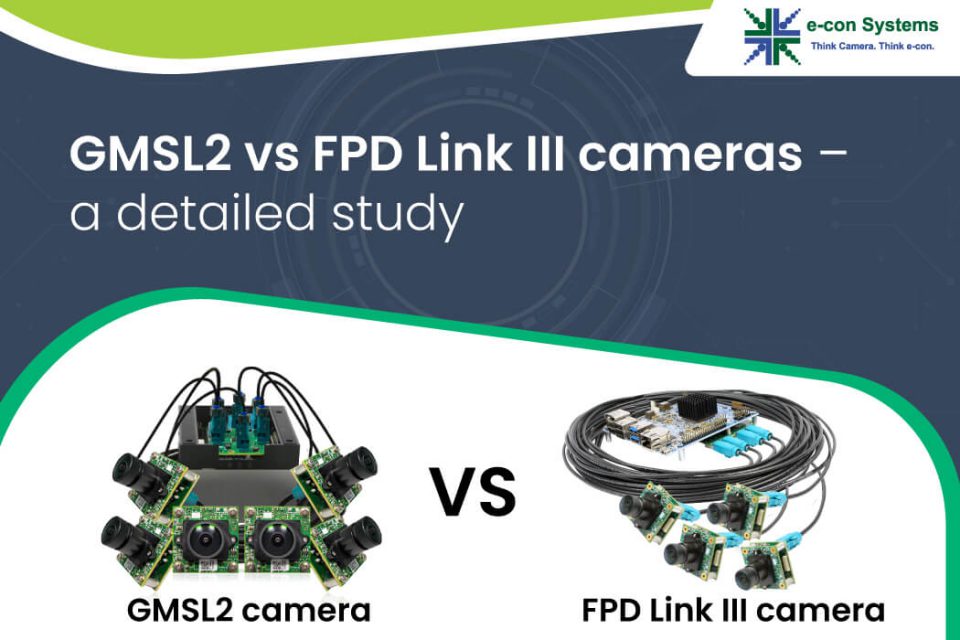GMSL (Gigabit Multimedia Serial Link) and FPD-Link (Flat Panel Display Link) are two of the most popular interfaces used in embedded vision for high-bandwidth long-distance transmission. And of all the releases in the two series, GMSL2 and FPD-Link III can be said to have gained the highest popularity owing to their features, performance, and wide adoption in high-end camera applications.
Though both GMSL2 and FPD-Link III are pretty similar in terms of their features, there are some structural and architectural differences. This article is written to perform an end-to-end comparison of the two interfaces – be it about their features, architecture, performance, or applications.
The underlying technology behind GMSL2 and FPD-Link III interfaces
Both GMSL2 and FPD-Link III are SerDes-based data transmission methodologies. SerDes is a technique developed to increase the speed of data transmission by converting parallel data into a serial stream at the transmitter end and converting it back to parallel data at the receiver end.
Conversion of parallel data into the serial stream is done using what is called a serializer while the conversion back to parallel data is done using a deserializer. Hence the name SerDes (Serializer/Deserializer).
Some of the key advantages of the SerDes technology include:
- It offers long-distance transmission at high speed with very low latency.
- SerDes interfaces and cables are highly resistant to shocks and vibrations. Hence they are suitable for use in harsh industrial environments.
- Though they are predominantly designed for automotives, since GMSL and FPD-Link are industrial-grade, they can be used for other applications such as AMRs (Autonomous Mobile Robots) and other autonomous and manual vehicles.
What are GMSL2 cameras?
GMSL2 cameras use the GMSL2 interface to transmit data from the camera to the host. Maxim Integrated (the designers of the GMSL interface) defines the GMSL family of interfaces as given below:
Gigabit Multimedia Serial Link™ (GMSL) serializer and deserializers (SerDes) are high-speed communication ICs that fully support the high bandwidth, complex interconnect, and data integrity requirements needed to support evolving automotive infotainment and advanced driver assistance systems (ADAS).
The latest among the GMSL family is the GMSL3 technology. Though it is more advanced, GMSL2 does the job for most modern embedded vision applications with the ability to transmit data at an FC (Forward Channel) and BC (Backward Channel) bandwidth of 6Gbps & 187Mbps respectively. The connection is done using a coaxial Shielded Twisted Pair (STP) cable or a Shielded Parallel Pair (SPP) cable.
Given below is the block diagram of a GMSL camera:

Figure 1 – GMSL camera system
GMSL2 supports the MIPI & parallel forward interfaces and the I2C & UART backward interfaces. This makes transmission smooth and convenient. It can also transmit data up to a distance of 15 meters.
What are FPD-Link III cameras?
FPD-Link III is a long-distance transmission interface developed by Texas Instruments. The creators of the interface position FPD-Link III for applications such as ADAS, security & surveillance cameras, industrial systems, and medical imaging. Like GMSL2, FPD-Link III cameras also offer a maximum data transmission distance of 15m.
When it comes to bandwidth, FPD-Link III offers FC & BC bandwidth of 4.16Gbps and 50Mbps respectively. In addition, the single-ended coaxial or Shielded Twisted Pair (STP) cable supported by the interface is of automotive grade, and can be used in a wide variety of vehicles – from automotive to robots and tractors.
 Figure 2 –Typical architecture of an FPD-Link III camera
Figure 2 –Typical architecture of an FPD-Link III camera
FPD-Link III is a D-PHY v1.2 and CSI-2 v1.3 compliant system interface and supports up to 4 data lanes at 832 Mbps per each lane. Further, it also supports four virtual channels for enabling additional bandwidth.
GMSL2 cameras vs. FPD-Link III cameras – a feature-by-feature comparison
Now that we understand what the two interfaces are, it’s time to do a side-by-side comparison of the technical features and specifications of GMSL2 and FPD-Link III.
The below table illustrates the same:
| Feature/parameter | FPD-Link III | GMSL2 |
| Backward Interface | I2C | I2C & UART |
| Forward Interface | 4 lane MIPI CSI 2 | MIPI & Parallel interface |
| Package Size | 5mm x 5mm | 7mm x 7mm |
| Operating Temperature | –40°C to +125°C | –40°C to +125°C |
| Bandwidth for FC & BC | 4.16Gbps & 50Mbps | 6Gbps & 187Mbps |
| GPIO supported | 4 | 10 |
| Audio transmission | Possible | Not possible |
| Synchronization | Possible | Possible |
| Max. Cable length | 15m | 15m |
Table 1 – feature comparison of GMSL2 and FPD-Link III
Out of the many features, let us delve into the details of some of the most important ones, which are:
- Bandwidth
- Distance of transmission
- EMI/EMC performance
- Virtual channel support
- Multi-camera support
- Platform compatibility
Bandwidth
We have already seen how GMSL2 and FPD-Link III fare in terms of bandwidth (please check Table 1). We could say that GMSL2 has a slight edge over FPD-Link III. However, both interfaces meet the data transfer needs of new-age camera-based embedded systems.
Distance of transmission
The two interfaces are neck to neck in terms of the distance to which image and video data can be transmitted. GMSL2 as well as FPD-Link III have the ability to connect cameras that are placed as far as 15 meters from the host.
EMI/EMC performance
GMSL2 cameras are designed with spread spectrum capability and HIM (High Immunity Mode). This provides more reliable reverse channel communication. This in turn leads to better EMI (Electro Magnetic Interference) performance and Electro Magnetic Compatibility (EMC) tolerance.
When it comes to FPD-Link III, as an option for mitigating EMI/EMC, the interface is capable of tolerating a REFCLK with spread spectrum clocking (SSC) profile with up to ±0.5% amplitude deviations (center spread) or up to 1% amplitude deviations (down spread) and up to 33-kHz frequency modulation from a clock source (source: Texas Instruments).
This makes FPD-Link III suitable for use with respect to EMC or EMI performance.
Virtual channel support
Being SerDes techniques, GMSL2 and FPD-Link III are designed to support virtual channels. For dual 4-lane MIPI CSI-2, a GMSL deserializer, can effectively decode up to 16 virtual channel IDs. On the other hand, FPD-Link III supports up to 4 virtual channels.
Multi-camera support
Both GMSL2 and FPD-Link III support multi-camera configuration with the ability to do synchronized streaming. In FPD-Link III, together with a companion deserializer, the serializer delivers precise multi-camera sensor clock and sensor synchronization (please refer Figure 2 to see the architecture of an FPD-Link III camera).
Platform compatibility
GMSL2 and FPD Link III cameras are compatible with most of the popular processing platforms in the market. However, the camera kit has to be designed in a way that it can be readily evaluated with the desired platforms.
For instance, e-con Systems’ GMSL2 and FPD-Link III cameras are compatible with platforms including NVIDIA Jetson AGX Orin, AGX Xavier, Xavier NX, TX2 NX, and Nano. Please visit the GMSL2 cameras and FPD Link III cameras pages to know more about e-con’s complete portfolio of cameras for the two interfaces.
Final words
GMSL2 and FPD-Link III are fairly similar when it comes to most of the features. Picking the right interface for your embedded vision system needs to be done by considering a multitude of factors. It is always recommended to take the help of an imaging expert like e-con Systems before you choose one for product development.
To find the perfect camera for your embedded vision system, please visit the following pages:
- Camera Selector (to view our entire portfolio of cameras)
- GMSL2 cameras (to view all our GMSL/GMSL2 cameras)
- FPD-Link III cameras (to browse through our FPD-Link III cameras)
If you are looking for help in integrating cameras into your device, please don’t hesitate to write to us at camerasolutions@e-consystems.com.

Prabu is the Chief Technology Officer and Head of Camera Products at e-con Systems, and comes with a rich experience of more than 15 years in the embedded vision space. He brings to the table a deep knowledge in USB cameras, embedded vision cameras, vision algorithms and FPGAs. He has built 50+ camera solutions spanning various domains such as medical, industrial, agriculture, retail, biometrics, and more. He also comes with expertise in device driver development and BSP development. Currently, Prabu’s focus is to build smart camera solutions that power new age AI based applications.




